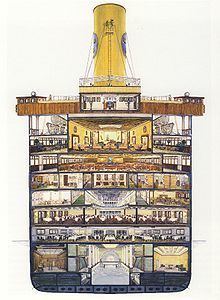Maiden voyage 1928 Fate Scrapped, 1965 Launched 1928 Draft 12 m Builder Blohm + Voss | Type Passenger liner Length 181 m Beam 24 m | |
 | ||
Name Kungsholm (1928-1942)John Ericsson (1942-1947)Italia (1948-1964)Imperial Bahama (1964-1965) Owner Swedish American Line (1928-1942),US Government (1942-1947)Home Lines (1947-1964)Freeport Bahama Enterprises (1964-1965) | ||
MS Kungsholm was a passenger liner owned and operated by the Swedish American Line from 1928 to 1941 on transatlantic services from Gothenburg to New York City as well as cruising out of New York. It was built at the Blohm & Voss shipyard in Hamburg, Germany.
Contents
Trans-Atlantic passenger service
Kungsholm operated on the trans Atlantic service with some cruise operations just prior to World War II.
In June 1938, as flagship of the Swedish American Line, she visited Wilmington, Delaware with the Crown Prince Gustaf VI Adolf and Crown Princess Louise of Sweden, members of the Royal Swedish Commission, the Commission of the Republic of Finland and tourists aboard. The visit was in honor of the 300th anniversary of the Swedish landing with the Crown Prince's son Prince Bertil having to do the honors ashore as the Crown Prince was suffering from a kidney attack.
For a brief time 1940-41, as Kungsholm was cruising the Caribbean after war broke out in Europe, the author J. D. Salinger was employed aboard as entertainment director.
Wartime service
The ship, under the command of Captain John Nordlander, was requisitioned effective 31 December 1941, placed under control of the United States Government's War Shipping Administration (WSA), renamed John Ericsson and delivered for contract operation by United States Lines as a troop transport largely to meet Army requirements.
John Ericsson was one of seven transports hurriedly assembled in New York and sailing late on 22 January 1942 (23 January GMT) in what was then the largest troop movement attempted, movement of POPPY FORCE, also designated Task Force 6814, under General Alexander Patch to secure New Caledonia (codename POPPY) on the vital South Pacific link to Australia. At the time this force was being assembled the ship was allocated to the State Department and with its addition and cutting troops in convoys across the Atlantic the seven ships assembled had a troop capacity of almost 22,000. Task Force 6814 was later organized in New Caledonia as the Americal Division.
John Ericsson was among the group of large, fast troop transports, capable of running without escorts, that moved freely among wartime theaters as required and included the large British liners, several allied liners, Navy and Army operated vessels and her WSA agent operated sisters SS Argentina, SS Brazil, SS Lurline, SS Mariposa, SS Monterey, and SS Uruguay.
Postwar service
Following the end of World War Two the John Ericsson was placed in the Hudson reserve fleet 28 April 1947 with fire damages estimated at between $500,000 and $1,500,000 to repair and offered for sale by bids 5 May on an "as is, where is" basis. The ship was sold back to the Swedish American Line with title passed on 18 July and the ship delivered to Swedish American Line 23 July 1947.
Instead of returning to service with Swedish American Line the vessel was sold to Home Lines in 1948 and renamed MS Italia. With Homes Lines the ship served on a variety of routes, including Genoa—South America, Genoa—New York, Hamburg—New York, Hamburg—Quebec, Bremen- Quebec, New York—Nassau as well as cruises from New York to the Caribbean. In 1964 the ship was sold to Freeport Bahama Enterprises for use as a floating hotel under the name MS Imperial Bahama. In 1965 the Imperial Bahama was scrapped at Bilbao.
